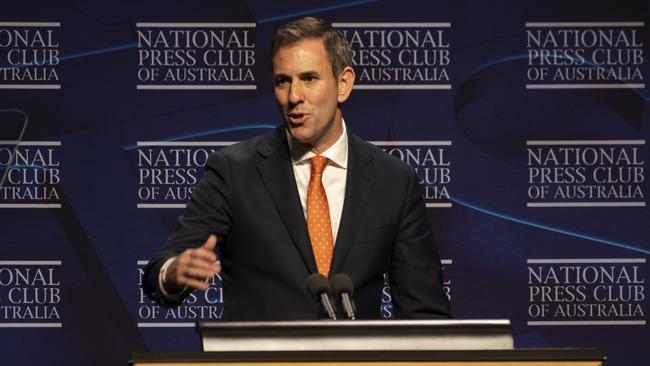
“Whether in politics or in life, I think we appreciate being brought in, not talked down to, or talked past,” Chalmers told diners in Parliament’s Great Hall.
“That’s been a practice more breached than honoured in our recent politics – from my perspective, it’s probably one of the things that has most unmoored public life from public esteem,” he said.
The Treasurer conceded he didn’t always get it “bang on”, preferring “the blunt over the polished”. He vowed to bring voters into his confidence in coming months about the longer-term position of the budget, including “our priorities as a country, and the choices we need to make to honour and pay for them”.
Decoded, we need to talk about tax.
So when is it going to start?
Australia’s evolving compact for more spending on health, aged care, the National Disability Insurance Scheme and defence is now less likely to be funded by offsets. That ship has sailed after Labor’s initial assault on “waste and rorts” in Tuesday’s budget. The easy wins are in the bank; the next wave of cuts is likely to make enemies, maybe within Labor’s tribe. We may see the dreaded “efficiency dividends” that annoy bureaucrats but tend to confirm ministers have run out of ideas.
Chalmers made much of his prudence and restraint in his first budget by taking virtually all of the revenue windfall from high commodity prices and a stronger economy to improve the budget’s bottom line. By the Treasurer‘s figuring, this was the biggest ever instance of returning tax upgrades to the budget – $124bn over the forward estimates, excluding GST, and $114bn returned to the budget, or 92 per cent.
Looking into the mist of every budget and update for the past 25 years, Chalmers said there had been 33 occasions when tax receipts had been upgraded. On average, across those revisions, about 60 per cent had been spent, and about 40 per cent had been returned to the bottom line.
There have been 14 occasions where all of a tax receipt upgrade was spent, and not a cent returned to the budget: 12 under John Howard and Peter Costello and two under Scott Morrison and Josh Frydenberg.
Of course, Chalmers didn’t mention that bar his first budget, Costello nailed a budget surplus or near balance for 11 straight years. Keeping Howard’s hands off windfalls to build his political dynasty became a Sisyphean struggle for the Liberal custodian
During the election campaign, the major parties abandoned the tax space. Helpfully, Treasury secretary Steven Kennedy filled the void by being the adult in the room. In a speech in June, Kennedy outlined the long-term spending pressures baked into the budget that Chalmers has been highlighting ever since and a sub-optimal tax system under strain.
The news is in: big government is here to stay and that means a higher haul. “The effects of a larger tax take can be minimised by ensuring the design of the tax system is optimal,” Kennedy told the Australian Business Economists
Our tax regime is like Swiss cheese: random holes everywhere. No wonder Australia is one of the world’s tax-planning centres of excellence. Because of such leakages, there’s an increasing fiscal burden on ordinary wage and salary earners who can’t access these tax shelters.
In a decade, without further tax relief (and assuming the stage three cuts start in July 2024), the average personal income tax rate rises to record levels. As well, tax as a share of the economy is likely to exceed the 23.9 per cent benchmark the previous government imposed as a fiscal discipline.
“We will need a tax system fit for purpose to pay for these services that appropriately balances fairness and efficiency,” Kennedy told the ABE. “This is achievable.”
Chalmers has been killing with a dead bat tax options bowled up to him during budget season, including raising and broadening the GST and a British-style super-profits tax on gas producers. He’s left open reform of the Petroleum Resource Rent Tax.
The greatest potential for fixing the tax tank is likely to be in “tax expenditures”, or concessions, benefits or incentives delivered to taxpayers through the tax system – but that typically lead to a loss of revenue. The cost of these must be reported by the end of January each year under the Charter of Budget Honesty.
As Treasury has explained, tax expenditures come in many forms, including tax exemptions, tax deductions, tax offsets, concessional tax rates or deferrals of tax liability. Superannuation tax concessions are expected to cost $52.6bn this year. Exemptions on the main residence are worth almost $63bn, while exemptions for food and education cost $8.7bn and $5.5bn, respectively.
“Tax expenditures may also redistribute the tax burden between taxpayers as most tax expenditures result in less tax being collected from particular taxpayers,” Treasury explains in a guide to these measures.
“As a result, taxes paid by individuals and businesses not benefiting from the tax expenditure need to be higher to raise the same total revenue.”
In an appendix in the budget papers, Treasury says the government will publish an enhanced Tax Expenditures Statement this financial year: “This will highlight distributional analysis for select major areas of tax expenditures, providing greater transparency to the public.”
You can bet this work, when it is published, will be red-hot; it will shape the coming debate on tax, showing which households and income groups win and lose from these tax “spends”; and it will see Labor’s trainee Razor Gang – if it is actually run by adults and serious about budget repair and sustainability – sharpening its tools.







One of the not-at-all “humble brags” Jim Chalmers keeps rolling out is there’s a new “tone” across the nation. While doing his community rounds, the Treasurer claims people constantly tell him “the adults are back in charge”. In his post-budget address to the National Press Club on Wednesday, the Treasurer reprised the line – with interest.